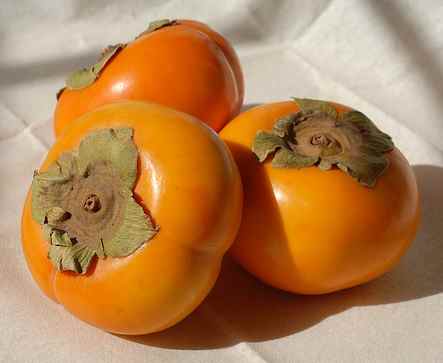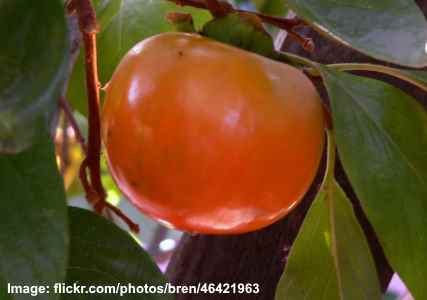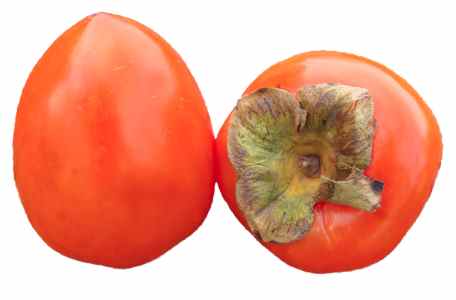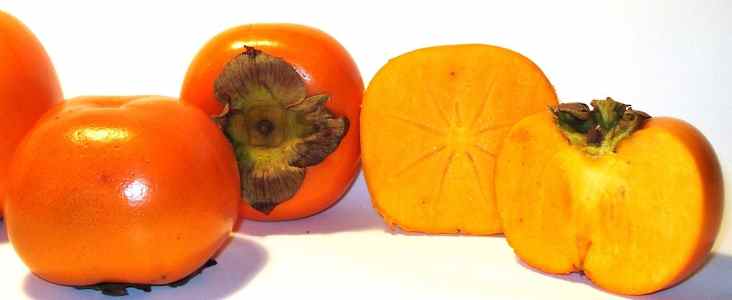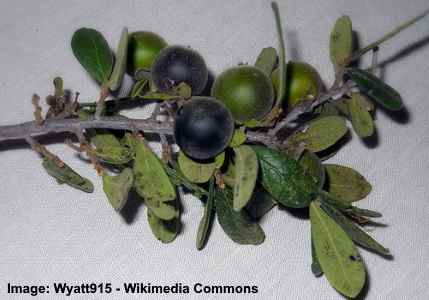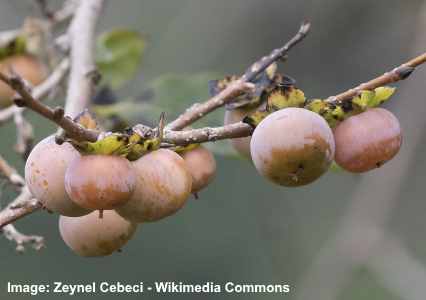Types of Persimmons: Persimmon Varieties from Around the World (With Pictures)
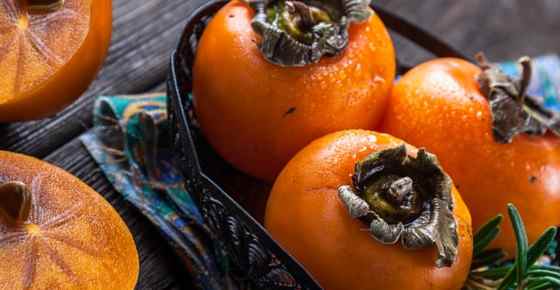
Persimmons are a type of orange-colored fruit that looks like an apple or tomato. Some varieties of persimmons have an oval flattened shape like an orange tomato. Other kinds of persimmons have an acorn shape resembling an apple. What is common about all types of persimmons is their edible orange skin.
All varieties of persimmons are divided into 2 types of fruit – astringent and non-astringent. Astringent persimmons such as the Hachiya are high in tannins and will leave your mouth dry and pucker if they are not completely ripe. Types of non-astringent persimmons like the Fuyu and Jiro varieties are delicious to eat fresh right from the tree because they are juicy and sweet.
To enjoy eating astringent varieties of persimmons, you need to wait until they are fully ripe. This usually requires leaving a “puckering” type of persimmon for a few days after it was picked to allow it to ripen. You can tell when types of astringent persimmons are sweet and ready to eat when their flesh becomes very soft. Then, you can bite into the juicy fruit without your mouth puckering up and becoming dry.
Types of Persimmons (With Pictures and Names)
Knowing about the different kinds of persimmon can help you know how to choose the best, sweetest, and juiciest type of fruit. Even astringent varieties of persimmon become soft and sweet when left to ripen fully.
Did you know that there are actually over 400 different persimmon cultivars? Let’s look in more detail at the different varieties of persimmons, including some interesting types such as the chocolate persimmon and cinnamon persimmon.
Japanese (Oriental) Persimmon
Japanese persimmons (Diospyros kaki) originate in China and the Far East and this variety is an astringent type of persimmon. There are also varieties of Diospyros kaki (Japanese persimmon) cultivars such as Fuyu or Sharon fruit which are non-astringent.
Oriental persimmons that are non-astringent tend to have a spherical flattened shape covered by a thin shell-like skin. Some say that these fruits look like orange tomatoes.
Japanese persimmons, or Oriental persimmons, generally have high tannin content before they mature. This causes the orange fibrous flesh to be bitter and astringent. However, as the fruit ripens, levels of tannins drop and their flesh becomes significantly sweeter without any astringency.
So, to avoid the unpleasant taste in your mouth from Japanese persimmons, leave them to ripen for a few days. When the flesh softens, you can enjoy the rich honey-like juicy taste of a ripe persimmon.
Fuyu Persimmon
If you are looking for one of the sweetest persimmons to eat, then the non-astringent Fuyu persimmon is extremely delicious.
Because of their all-around sweetness and lack of astringency, Fuyu persimmons (Diospyros kaki ‘Fuyu’) are one of the most popular types of persimmons sold in stores. In Japan, these sweet persimmon species are called amagaki (literally “sweet persimmon”).
You can tell a Fuyu persimmon by its squat, tomato-like shape and rich orange color. With this persimmon variety, you can eat it while the flesh is still quite firm and it won’t cause any puckering.
Rather than have a round shape like an apple, Fuyu persimmons have an oblate, almost 4-sided shape. The deep-orange fruits can measure up to 2 ¾” (7 cm) across and rarely contain any seeds.
As Fuyu persimmons mature, the sweet firm flesh gradually becomes softer, almost gelatinous. However, the lack of tannins in the fruit means that it has sweetness whenever you eat it.
Some describe the taste of ripe Fuyu persimmons as a sweet pear with the taste of dates and the richness of apricots.
If you live in a warm climate with frost-free winters, you can also buy Fuyu dwarf persimmon trees. These small fruit-bearing trees produce an abundance of juicy sweet fruits in the fall.
Giant Fuyu Persimmon
When you see and taste a Giant Fuyu (Gosho) persimmon, it’s not difficult to see why they are called the “fruit of the gods.”
Giant Fuyu persimmons are larger than typical Fuyu persimmons. The thick orange skin becomes much redder as it ripens and is one of the darkest of the persimmon varieties. The tannin-free firm flesh is deliciously sweet when you bite into it. This giant Japanese variety of persimmon is also about twice the size of regular Fuyu fruits.
Compared to some other types of astringent-free persimmons, the Giant Fuyu has a rich sweet flavor that some compare to sweet apricots or dates with hints of sugar cane.
Jiro Persimmon
Another delicious non-astringent type of persimmon is the Jiro persimmon (Diospyros kaki ‘Jiro’). The sweet orange fruit contains few tannins and can be eaten straight off the tree.
Jiro persimmons have a similar shape to Fuyu fruits and is also a type of Japanese persimmon. They resemble a firm orange tomato with light green leaves on the top of the fruit. Even biting into its firm flesh won’t cause your mouth to pucker as the Jiro persimmon is very sweet.
Because you can eat this non-astringent variety when it’s firm, it is sometimes called the “Apple persimmon.”
The smooth light-orange skin of Jiros is edible and these persimmons are best consumed raw. However, you can use this sweet fruit along with savory items to make delicious snacks.
Imoto Persimmon
Imoto persimmons are another variety of Japanese cultivar that doesn’t have any astringency and is extremely sweet.
These non-astringent persimmons have a similar squat shape to Fuyu and Jiro persimmons. When ripe, their skin is a more reddish-brown rather than bright orange color. However, they are just as sweet as Fuyu and Jiro fruits and can be eaten when the flesh is still firm.
Izu Persimmon
Izu persimmon is small orange fruit that looks like a tomato or tiny pumpkin. These Asian persimmon cultivars are of the non-astringent type and are deliciously sweet.
Similar to Fuyu and Jiro persimmons, these “kaki” fruits are sweet when their flesh is still firm. When fully ripe, their edible skin has a dark orange appearance and pale orange flesh.
Hachiya Persimmon
The Hachiya persimmon is a common type of astringent persimmon that should only be eaten when ripe. These are large persimmon fruits when compared to Fuyu or Jiro persimmons.
Compared to the flattened Fuyu varieties, the Hachiya persimmon is an oblong heart-shaped type of persimmon. It has high levels of tannic acid which causes an unpleasant taste in your mouth when you eat it. However, once fully ripe, the soft gelatinous orange flesh is rich and juicy with no hint of bitterness.
If you buy these large varieties of persimmons in the store, you should leave them for a few days to ripen. As they mature, the tannin levels drop and sugar levels rise. When the flesh feels very soft, it is time to enjoy its heavenly sweetness.
To make an astringent type of persimmon ripen quicker, you can put them in a paper bag and store them beside bananas. To check if the Hachiya is sweet enough to eat, its green top should easily come away when you gently pull it.
Hyakume Persimmon (Cinnamon Persimmon)
One of the sweetest persimmons is the Hyakume persimmon. This is a short Japanese type of non-astringent persimmon that looks like an orange tomato.
Because of the peppering of brown specks throughout the bright orange flesh, the Hyakume is also called the Cinnamon persimmon.
The flesh of the Hyakume persimmon is very sweet even when firm. However, it’s when the orange-skinned Asian fruit ripens when the intense sweetness really comes out. The soft ripe flesh takes on a light cinnamon color and the taste of the persimmon flesh resembles brown sugar.
However, it is only the type of Hyakume persimmon that contains seeds which is the sweetest variety. Seedless variations of this persimmon cultivar may have a more bitter and astringent taste.
Some people say that Cinnamon persimmons taste like a cross between Fuyu and Hyachiya. They have the sweetness of Fuyu kaki fruits and the shape of Hyachiyas.
Sharon Fruit (Triumph Persimmon)
A very popular type of sweet, non-astringent persimmon is the Sharon fruit, or Triumph persimmon (Diospyros kaki Thunb.). In some countries, they are also called hurma.
Sharon fruits look like a large tomato that has an oval shape and squat appearance. These persimmon fruits have a deep orange, edible crunchy skin – somewhat like an apple. Apart from the stem and leaves on its top, you can eat the whole of the fruit as it is seedless and coreless.
The name “Sharon fruit” comes from the plains of Sharon in Israel where this variety of persimmon grows.
Other Types of Non-Astringent Japanese Persimmons
There are hundreds of varieties of sweet persimmon fruits to choose from. Here are a few more types of sweet Asian persimmons that won’t cause puckering when you bite into them:
- Yeddo-ich is a seedless sweet persimmon with thick orange skin and dark brown sweet flesh.
- Hanafuyu persimmons are oblong in shape and have a sweet taste if they are hard or soft.
- Suruga persimmon is a good-quality type of sweet fruit with no hints of astringent tannins.
- Shotgatsu is a flattened, doughnut-shaped persimmon with mildly sweet flesh.
American Persimmon
The American persimmon (Diospyros virginiana) is native to the Southern US and is an astringent type of persimmon before it ripens.
Other names for American persimmons include sugar plums, possum apples, or the common persimmon. Some people also refer to the American persimmon as the ‘date-plum,’ however, this is also a type of sweet Oriental persimmon variety.
The Diospyros virginiana tree produces orange-yellow fruits that can measure up to 2.5” (6 cm) in diameter. As with all astringent varieties of persimmons, you need to wait until the plump orange fruit has ripened completely. However, if you leave the fruit too long to ripen, the flesh will take on a mushy texture and it will be difficult to eat.
Many astringent types of these persimmons have an oblong shape that resembles an orange apple.
Maru (Chocolate Persimmon)
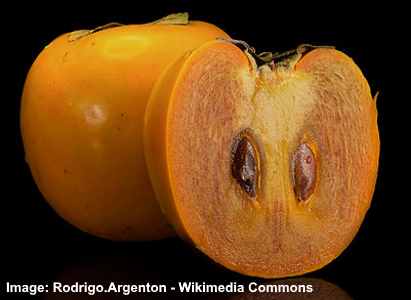
When unripe, the chocolate persimmon is astringent, but when fully ripe, the flesh becomes brown, like chocolate, ans sweet
An unusual type of persimmon with orange skin is the Maru variety, or Chocolate persimmon (also called Tsurunoko persimmon). These small-sized oblong persimmons look like Hachiya fruits and are also astringent until ripe.
The chocolate persimmon cultivar gets its name from the deep brown sweet flesh inside the juicy fruit. These Asian persimmon cultivars taste very sweet, but not overly sweet. Some people say that the soft dark flesh has hints of nutmeg when you eat it.
So, even though the flesh looks dark brown, don’t mistake it for being off or being spoiled. If you do so, you will be missing out on a wonderful treat.
Black Sapote (Chocolate Pudding Fruit)
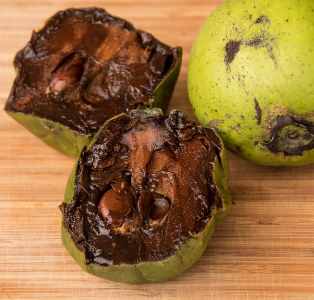
Black sapote is an astringent type of persimmon that when fully ripe has a texture and taste similar to chocolate pudding
Black sapote (Diospyros nigra) is a type of tomato-like persimmon native to Mexico, Central America, and parts of South America.
The fruits measure 5–10 cm (2.0–3.9 in) in diameter, and when they are unripe they are astringent and are inedible.
The skin of black sapote is inedible and has olive green color which turns yellow-green when ripe. The pulp is white, usually contains seeds, and inedible when unripe. But when the fruit is fully ripe, the pulp has chocolate color.
The black sapote persimmon is also called chocolate pudding fruit, black soapapple and zapote prieto (in Spanish).
The name chocolate pudding fruit comes from the color, texture and flavor which resemble chocolate pudding when ripe.
Texas Persimmon
One of the most unusual types of persimmons is the Texas persimmon (Diospyros texana). This persimmon tree produces small black fruits with a diameter of 1.5–2.5 cm that are surprisingly sweet when ripe.
Other names for the Texas persimmon include “black persimmon,” Mexican persimmon, or “chapote manzano” (in Spanish). These black fruits, like many persimmons, are quite astringent until fully ripe.
When the green fruit turns deep purple or black, they are sweet and good enough to eat off the tree. Unlike other sweet persimmon fruits, there are a number of seeds in the small fruits.
Velvet Apple Persimmon
Velvet Apple persimmons (Diospyros discolor or Diospyros blancoi) are another unusual type of tropical persimmon fruit. This persimmon species is also known as the Korean mango.
Because Velvet Apple persimmons only grow and are consumed in Asia, they are mostly unheard of in other parts of the world. The fruit is quite astringent until it becomes fully ripe. Unlike other types of Asian persimmons, these fruits have velvety skin and come in a range of colors.
The flesh of Velvet Apples (also called velvet persimmons) is generally white. The center contains a large number of seeds which means that there is not much to eat from each fruit.
Velvet persimmons are one of the few types of persimmon that don’t have edible skin. The furry skin gives off a strong cheese-like aroma and can cause irritation if you eat it. So, before consuming the sweet flesh, you have to remove the skin and seeds to prevent any bitterness.
Date-Plum Persimmon (Caucasian Persimmon)
One of the smallest types of persimmon is the Date-Plum persimmon (Diospyros lotus). The small orange fruits from the Diospyros lotus tree may only measure between 0.4” and 0.8” (1 – 2 cm) in diameter.
The Date-plum persimmon is also called the Caucasian persimmon or the lilac persimmon. This species of persimmon originates in East Asia but now grows in Mediterranean countries and in the United States.
This is an astringent type of persimmon that will make your mouth dry if you eat it before it’s ripe. However, when soft and fully ripe, the small persimmon fruits have a rich sweet flavor reminiscent of dates and plums.
The way to know if these types of persimmons are ripe is when the cherry-sized fruits become a dark purple plum color.
Related articles:

